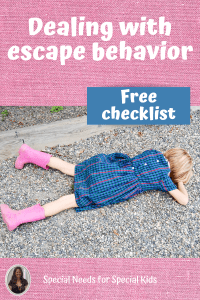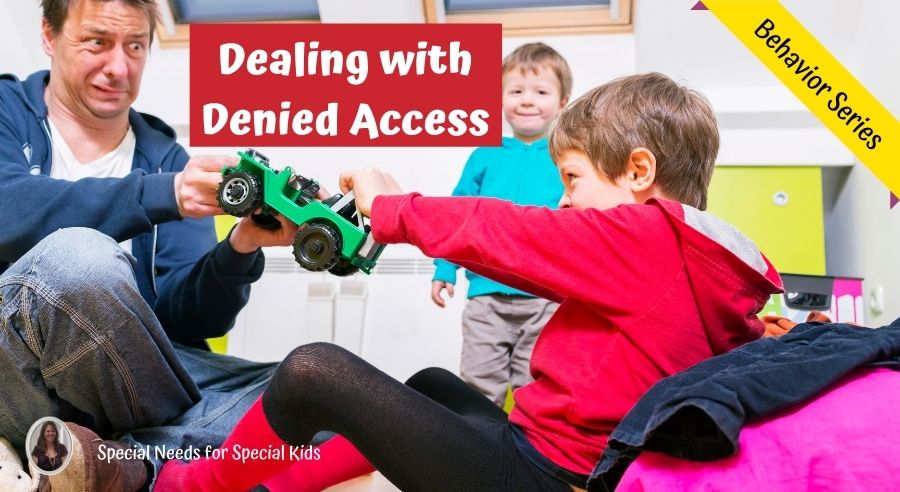This week, I want to focus on the common behavior problem that occurs when the student is denied access to something tangible, like a toy, food, or other reinforcing items. In my opinion, this can be the most dangerous and scary of the 4 types of common behaviors. Perhaps it is because it is the one behavior I deal with daily with my own son who can get quite aggressive assertive when he cannot have something he wants. When I was in my classroom, I also found this was the most common behavior problem that led to having to clear the room, or an incident report being filed (because an adult got injured.) Here is the good great news: I am awesome at figuring out how to manage this common behavior.
At the end of this post, I have a free social story you can download, “That’s not Mine,” to help you deal with this issue.
There are 3 main strategies I use when I realize that a student is having a behavior because he/she wants access to something he/she currently does not have. The sooner you recognize this function and take steps to intervene and develop more appropriate responses the better.
1. Learning how to accept no
This is a critical skill that we often take for granted. If you are a mom, or you had a mom, then you have probably heard, “Because I said so.” Growing up, I never got a detailed, thought out explanation why I could not do something. If the answer was “no,” then that was the end of the discussion. I was not a kid who would throw a temper tantrum, but I was able to rationalize in my head why the answer was probably “no” and if that answer might change later.
Most of our students do not have that insight. They hear “no”, and it can be like a trigger. We call it a learned stimulus or discriminative stimulus (SD) in the behavior world. The cycle goes like this:
- The student hears “no”
- Student employs an explosive behavior
- Adults, in order to keep everyone safe, give the student what he/she wants
- Explosive behavior is reinforced
- The explosive behavior is tied to the word “no” through that positive reinforcement and will likely be used in the future when he hears that word again
See how easy that common behavior can happen and get accidentally reinforced? Our intentions are only to keep everyone safe. Even when we KNOW we are reinforcing this undesirable behavior; our backs are against the wall. What else can we do?
Once you have identified this pattern and it is tied to the function of trying to gain access, you can start to strategically work on “un-linking” the word “no” and this behavior. First, start setting up situations where it is easy or desirable for the student to accept “no.” This takes some vigilance on your part. Watch throughout the day for requests the student makes that may not be all that desirable. I find students will request all the time to get out of something or to request something. Sometimes, they do not even want that thing they are asking for. If you can find these instances, then say “no” and if the student accepts it, even for just a second or two, then reinforce that behavior with specific language, “great job accepting no” and give them something tangible/reinforcing (just not the thing they were originally asking for.)
I did this a lot in the classroom. I also did it with students who were NOT having trouble accepting “no.” The student I was most concerned with, however, was watching, listening, and seeing his classmates receive praise and other tangibles for accepting “no.” That started to sink in.
2. Learning to wait
Sometimes we can use the word “later” or “after this” instead of the word “no.” This is a strategy I always tell new people working with my son, Jimmy. The word “no” will evoke a negative behavior, but if you say “later” then Jimmy seems to be okay with that. We use this strategy A LOT to deal with this common behavior problem!! Here is the key, you must remember to deliver on your promise, and in a timely fashion. It is best to use a clear time definition, like after we finish this puzzle, or after we read this book. That way he knows approximately how long he will have to wait. Before delivering on your promise, be sure to use that specific reinforcement. Tell the student, “great job waiting, or great job waiting nicely.” You HAVE to use that word waiting.
What happens if the behavior erupts before you can deliver your promise? Yep, that happens to me a lot with Jimmy. (We currently have a waiting program running with him.) Remind the student when they will receive the reinforcement. Then try to hurry it up and get to that point before the behavior erupts again. If that does not work, then change the condition. Instead of “after the puzzle” say “after you give me a high five” (or some action that is easy for the student to do). I wish it were an easy plug and play formula, but it is not.
Take some data on this!! How long can the student typically wait before the promise is delivered? We started at just 20 seconds with Jimmy and are now only up to 45 seconds after a couple of weeks. It takes time, especially if you have older kids who have a long history of being reinforced for negative behaviors.
3. Setting the environment up for success
So, this is my favorite of the three, and I am really good at it!! You must know your students fairly well for this to work, but once you get it dialed in, you are gold!!
Going back to my son, Jimmy, he is a big guy. When he gets angry it can be dangerous. Add to that, I almost always here alone with him (my husband travels, and Jimmy has scared off every worker I have had so far.) So, for my safety and the safety of my property, I have been able to eliminate certain cues that will set off this common behavior. I do not keep his favorite foods out where he can see them. We have a very clearly defined day of the week we get to go to McDonald’s (this took some work.) I use specific containers so he knows exactly how much of a certain food he will get, and no more. And, we follow a strict routine.
You can easily set up your classroom, in the same way, to help minimize this common behavior problem. If you have a student obsessed with a certain reinforcer, make sure it is not in view. You may have to eliminate some reinforcers all together if it is just too hard for the student to give it up or be denied access to it. Use as many visual cues (if he is a visual learner) as you can to add structure and routine to your day. And, the student comes in at the start of the day in an “off” mood, then be very, very choosy about what you say “no” to. If I can tell Jimmy is just “off” I try to make sure there are as few times as possible I have to say “no” that day. I would rather him have an extra bowl of chips than say “no,” then have him attack me, and get the chips anyway. Luckily, these few times this has happened (2-3 times a month) does not seem to disrupt our normal patterns.
Watch the video below on this common behavior problem
I would encourage you to watch the video below. I think I do a better job relaying these points, and with more examples than I have space to do here.
Grab your free social story, That’s Not Mine by clicking the button below.
Just remember when dealing with this common behavior:
- Teach students how to accept “no”
- Teach students how to wait
- Set up your environment for success
If you missed the first in this series, be sure to check it out. It is about how to deal with escape behaviors, and there is a free checklist to download. CLICK HERE to read more.



2 Comments
Comments are closed.